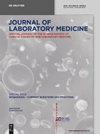循环无细胞DNA及其在癌症中的临床应用
IF 1.8
4区 医学
Q4 MEDICAL LABORATORY TECHNOLOGY
引用次数: 2
摘要
摘要液体活检是癌症患者诊断、预后和监测的有价值的非侵入性生物标志物来源。检测来源于肿瘤细胞(ctDNA)的循环无细胞DNA(cfDNA)已成为一种很有前途的临床方法,因为它们在许多癌症中的水平升高,并且含有肿瘤相关的突变和特定的甲基化模式。ctDNA可以从肿瘤细胞释放到血液中,与细胞外小泡(EV-DNA)连接,或者在与核小体和其他蛋白质结合时以无EV的形式释放,甚至作为大分子结构的组成部分,如中性粒细胞外陷阱(NET-DNA)。这些不同类型的cfDNA可以反映癌症的进展并预测患者的预后。这篇综述介绍了cfDNA在癌症中的最新益处,区分了EV-DNA和无EV-DNA,并强调了它们的临床实用性。本文章由计算机程序翻译,如有差异,请以英文原文为准。
Circulating cell-free DNA and its clinical utility in cancer
Abstract Liquid biopsies are a valuable non-invasive biomarker source for the diagnosis, prognosis and monitoring of cancer patients. The detection of circulating cell-free DNA (cfDNA) derived from tumor cells (ctDNA) has emerged as a promising clinical approach, as their levels are elevated in many cancers and contains tumor-related mutations and specific methylation patterns. ctDNA can be released from tumor cells into the bloodstream, either linked to extracellular vesicles (EV-DNA) or in an EV-free form when associated with nucleosomes and other proteins, or even as a component of macromolecular structures such as neutrophil extracellular traps (NET DNA). These different types of cfDNA can mirror cancer progression and predict patient outcome. This review presents the recent benefits of cfDNA in cancer, distinguishing between EV-DNA and EV-free DNA, and highlights their clinical utility.
求助全文
通过发布文献求助,成功后即可免费获取论文全文。
去求助
来源期刊

Journal of Laboratory Medicine
Mathematics-Discrete Mathematics and Combinatorics
CiteScore
2.50
自引率
0.00%
发文量
39
审稿时长
10 weeks
期刊介绍:
The Journal of Laboratory Medicine (JLM) is a bi-monthly published journal that reports on the latest developments in laboratory medicine. Particular focus is placed on the diagnostic aspects of the clinical laboratory, although technical, regulatory, and educational topics are equally covered. The Journal specializes in the publication of high-standard, competent and timely review articles on clinical, methodological and pathogenic aspects of modern laboratory diagnostics. These reviews are critically reviewed by expert reviewers and JLM’s Associate Editors who are specialists in the various subdisciplines of laboratory medicine. In addition, JLM publishes original research articles, case reports, point/counterpoint articles and letters to the editor, all of which are peer reviewed by at least two experts in the field.
 求助内容:
求助内容: 应助结果提醒方式:
应助结果提醒方式:


